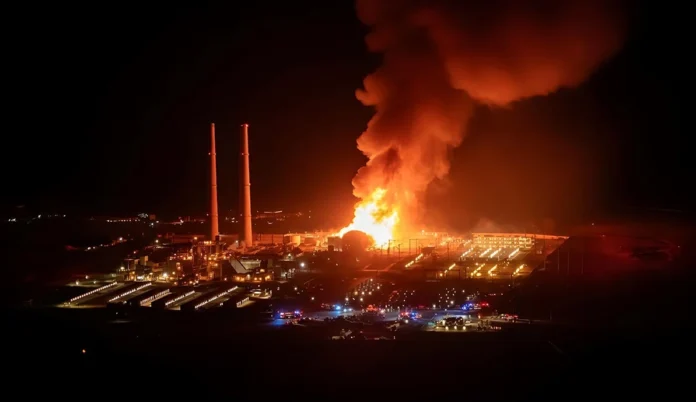Moss Landing Blaze Raises Alarms Over Growing Lithium Battery Dangers
MONTEREY COUNTY, California — A massive fire erupted at the Moss Landing Energy Storage Facility, forcing widespread evacuations and highlighting the serious dangers associated with lithium-ion battery technology, which has been aggressively promoted as the future of “clean” energy.
Authorities confirmed that the blaze began in a section of the plant where thousands of lithium-ion cells were stored. Within minutes, what started as a localized malfunction escalated into an uncontrollable inferno, spewing toxic smoke, shutting down major roads, and forcing nearby residents to flee.
“This was not a minor incident,” said Monterey County Fire Chief David Spears. “These batteries can’t simply be extinguished with water or foam. Once they ignite, they feed on themselves and burn hotter than almost anything we deal with.”
The Moss Landing fire is now being described as one of the most significant lithium-ion energy storage disasters in U.S. history, serving as another stark warning that this technology may be far less safe than consumers have been led to believe.
Lithium-ion batteries have become the backbone of the renewable energy movement, touted as essential for everything from electric vehicles to residential inverter systems. But behind the glossy marketing and “green” labels lies a dangerous truth: these batteries can and do explode.
In California’s case, the Moss Landing Power Plant was intended to symbolize a shift toward sustainable power, housing enough stored energy to supply hundreds of thousands of homes. Instead, it became a symbol of how unstable the technology can be.
“The system overheated, the temperature sensors failed, and the batteries began to combust,” a technician familiar with the investigation said. “Once one cell goes, it sets off a domino effect; thousands of batteries catch fire in seconds.”
The fire raged for hours before emergency crews were able to contain it. Even after visible flames were extinguished, thermal hotspots remained for days, reigniting without warning. Officials described the conditions as “toxic, unpredictable, and highly dangerous.”
As plumes of white-gray smoke rose over Monterey Bay, authorities ordered residents in nearby neighborhoods to evacuate. The air was thick with chemical fumes, including hydrogen fluoride, a poisonous gas released when lithium-ion batteries burn.
Residents reported burning eyes, nausea, and breathing difficulties as the toxic haze spread. Environmental groups are now demanding an investigation into the extent of contamination caused by the fire in the surrounding air and water systems.
“People were told these energy storage plants were safe,” said environmental advocate Lisa Torres. “Now families are coughing, schools are closed, and firefighters are being exposed to toxic chemicals. This is the real cost of these so-called clean technologies.”
The Moss Landing incident is far from isolated. Around the world, lithium-ion battery fires are becoming alarmingly frequent, from residential inverters in Nigeria and Germany to electric vehicle fires in Asia and Europe.
In each case, the pattern is the same: overheating, explosion, and uncontrollable fire. Once ignited, lithium-ion batteries enter a process known as thermal runaway, generating their own oxygen and heat in the process. Traditional firefighting methods often exacerbate the situation.
“This is the Achilles’ heel of lithium technology,” said Dr. Benjamin Carter, an energy systems safety researcher at the University of Michigan. “The chemistry itself is inherently unstable. It only takes one weak cell, one fault in cooling, or one bad batch from the manufacturer, and you’ve got a bomb.”
The growing list of global incidents is pushing experts to question whether lithium-ion should continue to be used in large-scale energy systems or even in homes.
Despite repeated warnings from engineers and safety experts, regulators have been slow to act. The energy industry continues to invest billions in lithium-based storage projects, arguing that they are critical for reducing carbon emissions.
However, critics argue that the Moss Landing fire highlights how safety has been compromised for profit and political gain.
“Companies love to talk about clean power, but they hide the fire risks,” said safety advocate and former engineer Mark Levingston. “These systems are being installed in cities, near homes, without proper fail-safes. We’re basically building fire hazards and calling it progress.”
In California alone, multiple energy storage fires have been reported in recent years, yet oversight remains minimal. Fire departments often lack the necessary training and equipment to combat lithium-related fires effectively.
While the Moss Landing facility is industrial, the underlying issue affects ordinary consumers as well. Lithium-ion inverter batteries, the same technology used at Moss Landing, are now standard in households, offices, and commercial buildings.
Poorly manufactured or improperly installed units can overheat, short-circuit, or explode. With the surge of imported, unregulated batteries entering markets, the threat is growing.
“Most people don’t even know what kind of batteries are sitting in their homes,” said Levingston. “They’re marketed as clean, quiet, and safe, but once something goes wrong, you’re dealing with a fire you can’t put out.”
Fire departments in the U.S. have reported dozens of home fires linked to lithium-ion inverter systems in the past year alone. The National Fire Protection Association (NFPA) has urged homeowners to ensure adequate ventilation, avoid overcharging, and never store these systems near flammable materials.
A Warning Ignored
As smoke clears over Moss Landing, one message rings loud and clear: lithium-ion batteries are not as safe as the industry claims.
The world’s rush toward renewable energy has created a dangerous blind spot. Instead of focusing on safer alternatives, such as solid-state batteries or non-flammable chemistries, corporations continue to mass-produce the cheapest lithium cells possible, putting profits above safety.
“This fire was preventable,” Chief Spears concluded. “But as long as we keep using unstable materials for energy storage, we’re going to see more of these disasters.”
The Moss Landing fire stands as a stark reminder: behind every promise of “green energy” lies a technology that can turn deadly in seconds. Until stronger regulations, safer designs, and honest consumer education become the norm, the subsequent explosion may be closer than anyone expects.
Read the Latest Battery News Shaping the Global Power Market
Lithium-Ion Batteries Ignite Huge Fire at California Power Plant- Source


